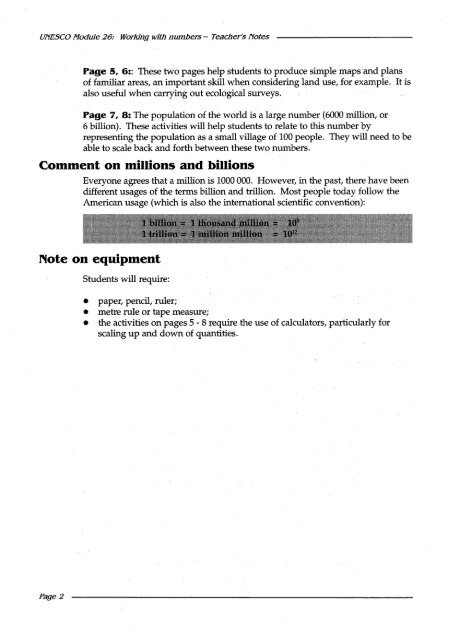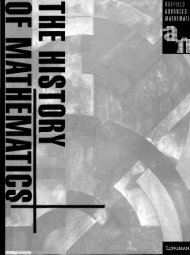- Page 3 and 4:
• UNESCO Inaworld increasingly sh
- Page 5 and 6:
Contents The/Origins and Purpose of
- Page 7 and 8:
( ) has involved practising teacher
- Page 9 and 10:
The Meaning of Scientific and Techn
- Page 11 and 12:
I \ < l 3 Fuels for the future 4 Pr
- Page 13 and 14:
,."1 l r ~ Formative
- Page 15 and 16:
~ ) • \ \.. • • Evaluating th
- Page 20:
UNESCOResource Kit Science & Techno
- Page 24:
Scientific & Technological Literacy
- Page 28:
There are two parts ·to each modul
- Page 32 and 33:
Acknowledgements Module I Name of U
- Page 34:
Acknowledgements (continued) 26 Wor
- Page 37 and 38:
Outline of the modules (continued)
- Page 39 and 40:
Outline of the modules (continued)
- Page 41 and 42:
Outline of the modules (continued)
- Page 43 and 44:
Outline of the modules (continued)
- Page 48 and 49:
Cars and energy UNESCOModule 1: Car
- Page 50:
Electric vehicles UNESCO Module 1:
- Page 53 and 54:
UNESCO Module 1: Cars and energy -'
- Page 55 and 56:
UNESCOModule 2: Oetting to school -
- Page 57 and 58:
UNESCO Module 2: Oetting to school
- Page 59 and 60:
UNESCO Nodule 2: Oetting to school
- Page 61 and 62:
UNESCO Module 2: Oetting to school
- Page 63 and 64:
UNESCOModule 2: Oettinq to school-
- Page 68 and 69:
Fuels for the future Which fuel is
- Page 70 and 71:
UNESCO Module 3: Fuels for the futu
- Page 72 and 73:
___ ...,....- UNESCOModule 3: Fuels
- Page 74 and 75:
------------------,..--- UNESCO Mod
- Page 76 and 77:
The ethanol debate UNESCO Module 4:
- Page 78:
-------------------- UNESCOModule 4
- Page 81 and 82:
UNesCOModule 4: Problems with fossi
- Page 84 and 85:
UNESCOModule 5: Oremulsion - an alt
- Page 86 and 87:
--- UNESCO Module 5: Oremulsion - a
- Page 88 and 89:
You live near the Switch Power Stat
- Page 90 and 91:
UNESCO Module 5: Oremulsion - an al
- Page 92 and 93:
The water cycle Control UNESCO Modu
- Page 94 and 95:
The water cycle The diagram shows t
- Page 96:
UNESCO Module 6: The water cycle *
- Page 101 and 102:
UNESCOModule 6: The water cycie= Te
- Page 103 and 104:
UNESCO Module 7: Sources of fresh w
- Page 105 and 106:
UNESCO Module 7: Sources of fresh w
- Page 107 and 108:
UNESCO Module 7: Sourcesoffreshwate
- Page 109 and 110:
UNESCOModule 7: Sources offresh wat
- Page 111 and 112:
UNESCO Module 8: Managing water res
- Page 113 and 114:
UNESCO Module 8: Managing water res
- Page 118 and 119:
Forests for the future UNESCOModule
- Page 120 and 121:
A forest survey 1 mature conifers 2
- Page 122 and 123:
The economic value of a forest UNES
- Page 124:
Healthy conifers UNESCO Module 9: F
- Page 127 and 128:
Notes on the activities UNESCO Modu
- Page 129 and 130:
UNESCO Nodule] 0: Tropical rain for
- Page 131 and 132:
UNESCOModule 10: Tropicalmin forest
- Page 133 and 134:
UNESCO Module 10: Tropical rain for
- Page 135 and 136:
UNESCO Module 11: Wood asafuel-----
- Page 138 and 139:
UNESCO Module 11: Wood as a fuel -
- Page 140 and 141:
UNESCOModule 12: Wood as a structur
- Page 142:
Problems with humidity UNESCO Modul
- Page 145 and 146:
UlYESCOModu/e 12: Wood as a structu
- Page 147 and 148:
UNESCO Module 13: Materials made fr
- Page 149 and 150:
UNESCO Module 13: Materials made fr
- Page 151:
UNESCO Module 13: Materials made fr
- Page 155 and 156:
UNESCOModule14: Understanding biodi
- Page 157 and 158:
UNESCO Module ·14: Understanding b
- Page 159 and 160:
UNESCO Module14: Understanding biod
- Page 161 and 162:
UNESCO Module 14: Understanding bio
- Page 163 and 164:
UNESCO Module 15: Cloning sheep Clo
- Page 165 and 166:
UNESCO Module 15: Cloning sheep 008
- Page 168 and 169:
UNESCOModule 15: Cloning sheep - Te
- Page 172 and 173:
-------------------- UNESCOModule 1
- Page 174 and 175:
UNESCO Module 16: Investigating pol
- Page 176 and 177:
Air pollution - instruction sheet M
- Page 178 and 179:
Pollution in the house anpeting UNE
- Page 180 and 181:
------------- UNESCOModule16: Inves
- Page 182 and 183:
-------------------- UNESCOModule 1
- Page 184 and 185:
---_-------------....,.------ UNESC
- Page 186 and 187:
--------------- UNESCO Module 17: S
- Page 188 and 189:
Noise pollution UNESCO Module 18: N
- Page 190:
----------------------- UNESCO Modu
- Page 193:
UNESCO Module 18: Noise pollution -
- Page 197 and 198:
UNESCO Nodule 19: Combined heat and
- Page 199 and 200:
UNESCO Module 19: Combined heat end
- Page 202 and 203:
UNESCO Module 19: Combined heat and
- Page 204 and 205:
Solar heating The Trading Post UfYE
- Page 206 and 207:
----------------------------------
- Page 208:
UNESCOModule 20: Solar heating Sola
- Page 211 and 212:
UNESCO Module 20: Solar beatinq »
- Page 213 and 214:
UNESCO Nodule 21: Photovoltaic syst
- Page 216 and 217:
------------------------ UNESCO Mod
- Page 218 and 219:
UNESCO Module 21: Photovoltsic syst
- Page 220 and 221: UNESCO Module 21: Photovoltaic syst
- Page 222 and 223: Refrigeration for medical vaccines
- Page 224 and 225: Solar powered sport at a Spanish sc
- Page 226: An optical fibre link for • Vietn
- Page 229 and 230: UNESCO .Module 21: Photovoltaic sys
- Page 231 and 232: UNESCO Module 22: Using wind power
- Page 233 and 234: UNESCO Module 22: Using wind power
- Page 236 and 237: --------------- UNESCO Module 22: U
- Page 240 and 241: Alcohol in your body The effects of
- Page 242 and 243: Burning up alcohol UNESCOModule 23:
- Page 244 and 245: -------------- UNESCOModule 23: Alc
- Page 246 and 247: Testing the quality of food UNESCO
- Page 248 and 249: Looking for Impurlties in food mate
- Page 250 and 251: UNESCOModule 24: Testing the qualit
- Page 254 and 255: UNESCO Module 25: Understandinq ecl
- Page 256 and 257: A Koman account UNESCO .Module 25:
- Page 258 and 259: _________ UNESCO Module 25: Underst
- Page 262 and 263: Working with numbers UNESCO Module
- Page 264 and 265: Making a million UNESCO Module 26:
- Page 266 and 267: Paces and spaces UNESCO Module 26:
- Page 268 and 269: The Global Village: Population UNES
- Page 272 and 273: Appendix 1 Project 2000+ steering C

















